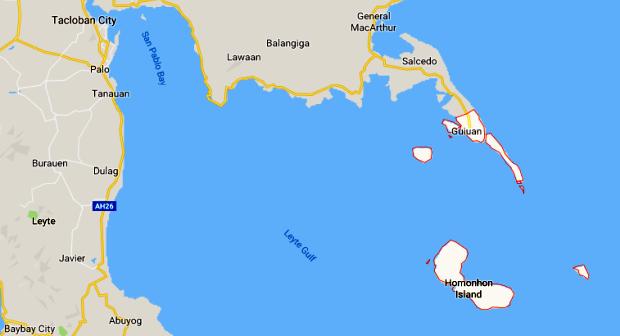
Guiuan (outlined in red) in Eastern Samar (Image from Google Maps)
MANILA, Philippines — Guiuan in Eastern Samar recorded the highest heat index in the country on Tuesday, the same day the province was struck by a magnitude 6.5 earthquake.
According to the heat index table released by the Philippine Atmospheric, Geophysical and Astronomical Services Administration (Pagasa), the heat index in Guiuan soared to 46.7°C around 11 a.m.
A heat index of 41°C or higher is considered to be at the “danger” level and poses health risks, said Pagasa.
The heat index was reported merely hours before a magnitude 6.5 earthquake rocked San Julian, Eastern Samar, at 1:37 p.m.
According to the Philippine Institute of Volcanology and Seismology (Phivolcs), however, earthquakes are not related to any weather phenomenon such as El Niño.
“Earthquakes are not affected by any weather. The origin of earthquakes are so deep that any temperature or extreme weather conditions do not affect them,” said Ishmael Narag, officer-in-charge of the Seismological Observation and Earthquake Prediction Division of Phivolcs
The agency said there had been 495 aftershocks following the Luzon earthquake and 21 for the Samar earthquake.
Heat index
As for the heat index, a total of 12 areas reported heat index considered to be at the “danger” level.
Aside from Guiuan, other areas that experienced high heat index include the following:
- Infanta, Quezon: 45.7°C
- Ambulong, Batangas: 44.1°C
- Dagupan City, Pangasinan: 44.1°C
- Cuyo, Palawan: 43.9°C
- Baler, Aurora: 41.9°C
- Casiguran, Aurora: 41.9°C
- Catbalogan, Western Samar: 41.9°C
- Roxas City, Capiz: 41.8°C
- Zamboanga City, Zamboanga del Sur: 41.6°C
- Iba, Zambales: 41.5°C
- Laoag, Ilocos Norte: 41.3°C
Pagasa advised people to stay indoors as much as possible, wear lightweight and light-colored clothing, and drink water regularly to keep cool.
/atm

